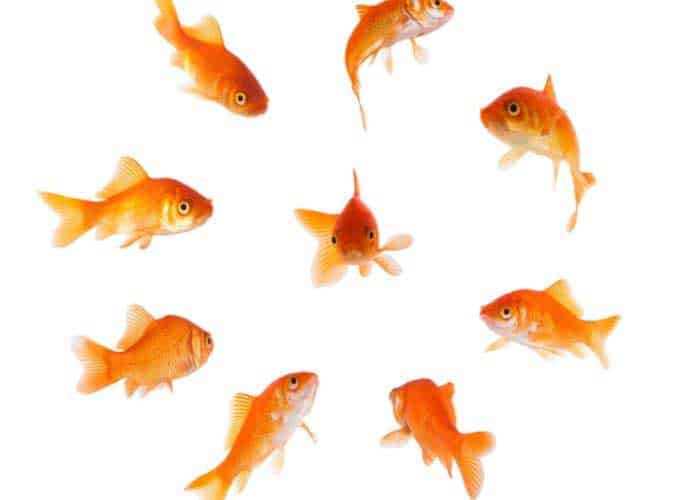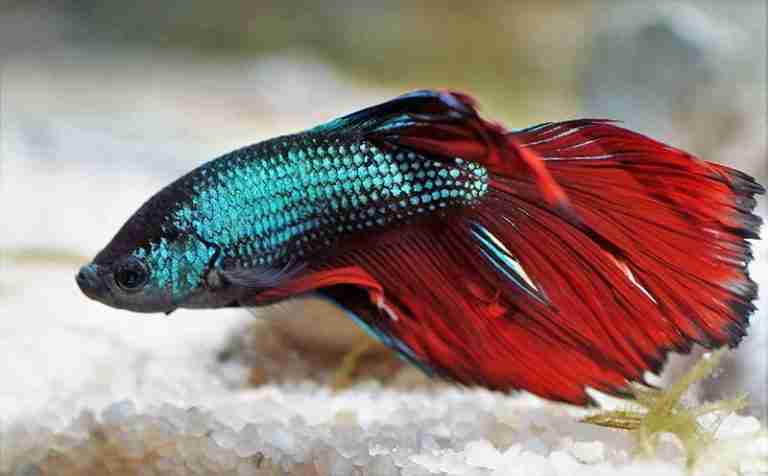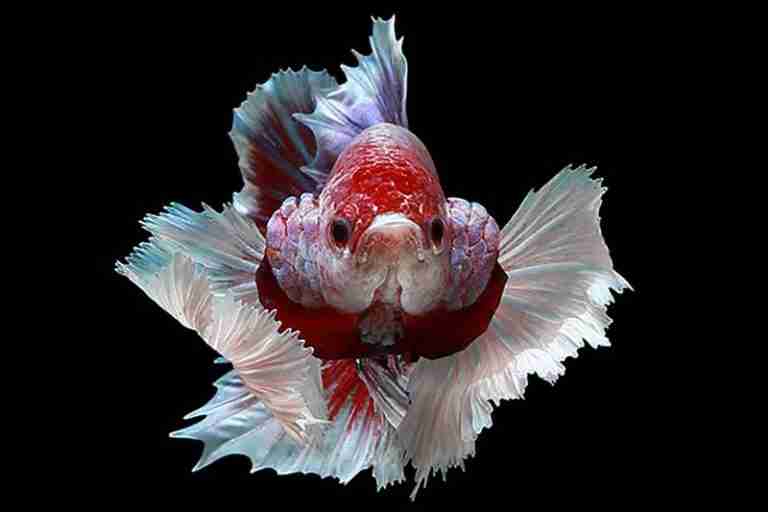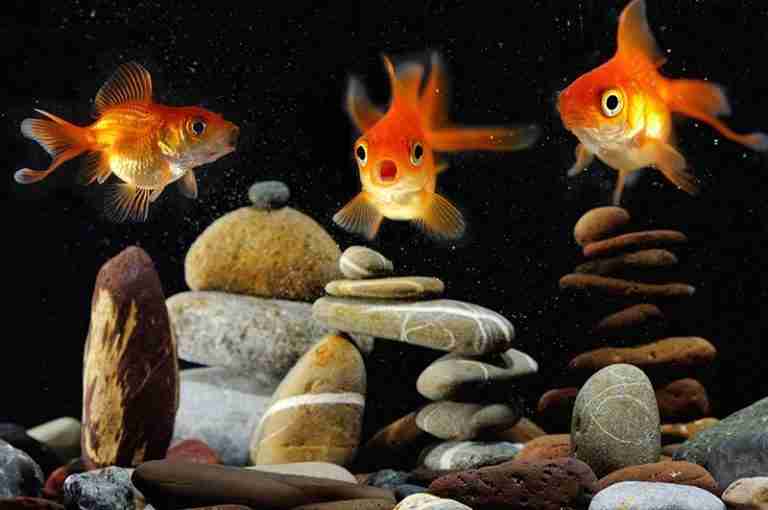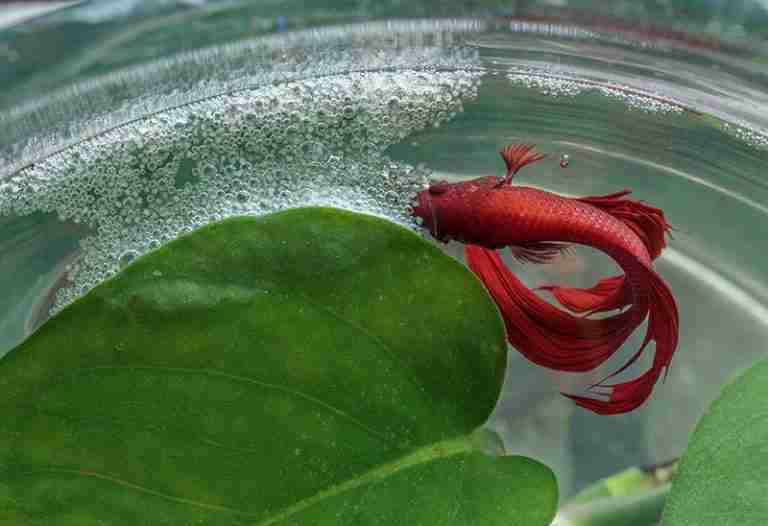Are Angelfish Aggressive (A guide to their temperament)
Angelfish are a very popular species of fish, found stocked in most pet shops and commonly found in community tanks, but are angelfish aggressive, and will they fight with other tank mates?
All angelfish can show aggressive behavior in certain situations, however, some saltwater species are more aggressive than their freshwater counterparts. Aggression comes in many forms, from chasing to fin-nipping, and is often a show of dominance over territory.
In this article, I will only discuss freshwater angelfish. I cover whether angelfish can be aggressive towards other fish, why they are aggressive, their suitability for community tanks, and what you can do to prevent or reduce angelfish aggression.
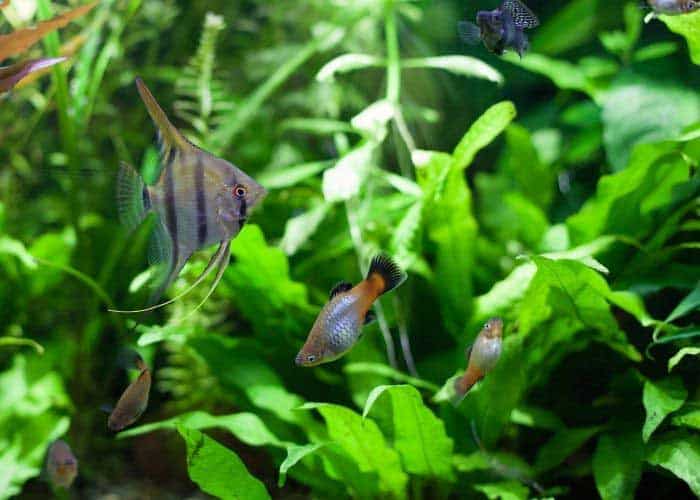
Are Freshwater Angelfish Aggressive
Freshwater angelfish are not known for their aggression, unlike Siamese fighting fish or some species of cichlids. Angelfish are typically a docile freshwater fish species that you can keep in most community tanks without any problems.
Answering the question, “Are angelfish aggressive?” is not straightforward. There are some situations where angelfish aggression can occur, so instead, it would make more sense to answer the question, “Why are angelfish aggressive?”
Too many angelfish in a small tank is a good example and is quickly solved. Small tanks will often lead to disputes over food and territory between some of the most peaceful fish.
If you are keeping angelfish in a community tank, it is essential to understand triggers that may cause aggressive behavior, and it is equally important to know which types of fish are best suited to live with angelfish.
Are Angelfish Aggressive Toward Each Other
Angelfish are not usually aggressive toward each other, however, this can change during their mating season. Aggression between breeding angelfish is quite normal during mating, where the males will fight for the attention of the females.
If you provide plenty of hiding places in the tank, you shouldn’t experience too many problems with angelfish aggression.
When male angelfish fight over a female, it will usually result in plenty of chasing and some nipping of fins. Angelfish tend not to fight until a severe injury occurs, and once dominance is established, everything will settle down.
Providing that your angelfish tank has plenty of room, both male and female angelfish will live peacefully together during mating season and other times of the year.
Can Angelfish Live With Other Fish
Angelfish can live with other fish and are a common sight in community tanks. Although compatible with many fish, there are a few species that you should avoid keeping with angelfish.
Angelfish can be territorial and prefer their own space in an aquarium, so it would be best not to mix them with other fish that can be aggressive and territorial. Angelfish tend to like being the only dominant fish in a fish tank.

Angelfish can also grow quite big, often around 6 inches when fully grown, so smaller fish may seem like an easy snack.
If you keep shrimp in your tank, don’t be surprised if you catch your angelfish chasing them around the tank. Freshwater angelfish originate in South America in the Amazon rivers, where shrimp are a natural food source.
Sometimes angelfish eat smaller fish unless kept in large numbers. Small fish such as tetras and guppies prefer to live in schools of 15 or more, and when in schools of this size, angelfish will usually leave them alone.
Angelfish attack from the fish’s rear when aggressive, nipping at the fins and tails. However, angelfish can also be a target for fin nipping, especially with their long delicate fins.
Despite what I have said above, there are many fish species that can live peacefully alongside angelfish, so you would need to do a little research into each variety before adding them to the tank.
Research is important because adding one aggressive fish can upset the delicate balance that has been established within your tank.
To help you get a feel for suitable tank mates, I will list a few species that usually mix well with angelfish, and I will list a few fish that you should avoid.
Good Angelfish Tankmates
Some suitable tank mates that typically mix well with angelfish are:
- Platies
- Mollies
- Harlequin Rasboras
- Small Loaches (such as Zebra Loaches)
- Dwarf Gouramis
- Tetras (in schools of 10 or more)
- Most Plecos
- Small Cichlid Varieties (such As Ram Cichlids)
- All Goldfish Species
This list is by no means exhaustive and instead just an example of the types of fish you will be looking to mix.
All fish in this list are peaceful fish that won’t interact much with angelfish. The smaller fish in this list are schooling fish and would need to be kept in schools of 10-15.
The angelfish lifespan is quite long, usually 10-12 years and sometimes up to 15 years, so it is important to put them with suitable tank mates in the early stages.
I found the video below on Youtube, which will talk you through a few more ideal tankmates for angelfish.
Bad Angelfish Tankmates
Some fish that often won’t mix well with angelfish are:
- Siamese Fighting fish (Betta fish)
- African Cichlids
- Silver Dollar Fish
- Most Shrimp Species
- Some shark species, such as Red Tailed Black Sharks or Rainbow Sharks
- Large Loaches like Clown Loaches
- Tiger Barbs
All the fish above are either confirmed fin nippers, have an aggressive nature, or are easy targets for angelfish.
Again, it will be down to you to carry out some research of your own before adding any fish to your aquarium.
How To Stop Angelfish Aggression
There are only a handful of reasons why angelfish become aggressive, making it much easier to reduce any aggression.
Angelfish are usually aggressive because they try to protect their territory, are hungry, or are breeding. Simply by removing the cause of the aggression, it will usually stop.
Below is a list of triggers that may set an angelfish off and some simple tips to reduce the behavior.
Aggressive Territorial Behavior
If your angelfish are attacking other fish because they are protecting their territory, you can try adding more hiding places in the tank for the other fish.
Angelfish like to live in densely planted tanks because they can also become stressed and need somewhere to hide.
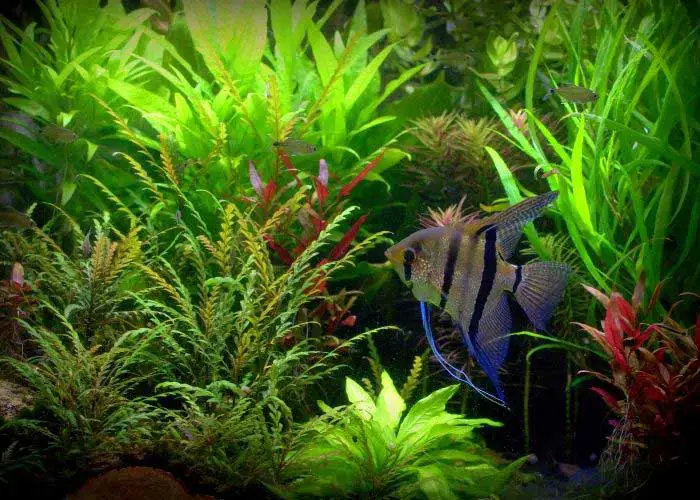
Not only are plants part of the angelfish’s diet, but they also have the benefit of providing a hiding place for other fish in the tank so they can keep out of the way of a stressed angelfish.
Other ideas to consider are ornaments or plastic tubes that create caves. Most fish will instinctively hide when threatened, so all fish in the tank will feel more comfortable by providing adequate hiding spots.
Aggression Through Hunger
If your angelfish attacks other fish because it’s hungry, adding some plants will reduce this behavior. You should ensure that your angelfish receive all of the nutrients they require at feeding time.
You can feed young angelfish 2-4 times a day, and as adults, this can be reduced to 1-2 times per day. You should provide a high-protein diet consisting of shrimp, bloodworms, tubifex worms, krill, and similar, which can be live, frozen, or freeze-dried.
Angelfish will happily eat the fish flakes and pellets you will probably feed the rest of the tank, but this may not be enough due to the angelfish’s size or when they are growing.
It may be difficult not to overfeed the other fish in the tank when trying to give your angelfish some extra food, but fish will get to know when they are about to be fed. Angelfish are greedy enough to gulp down the extra food before other fish in the tank can reach it.
Aggression from Stress
Another way to reduce aggression is to keep the tank clean. A dirty tank can often increase aggression as the fish become more stressed.
If your freshwater tank is dirty, it can cause ammonia levels to rise. A rise in ammonia levels can irritate the skin and gills of fish and reduce dissolved oxygen levels, all leading to an adverse change in behavior.
A dirty tank is also the perfect breeding ground for disease and parasites. A sick angelfish will be unhappy with a short temper, just like any fish would be.
Keep an eye on your aquarium’s water parameters, such as pH, ammonia, nitrites, and general hardness. The articles below will help give you a better understanding of these parameters.
Aggression Caused By A Small Tank
Tank size is critical. Angelfish are active fish that need plenty of space to swim around. A tank that is too small can lead to increased aggression, and this is true for any territorial fish that will fight for their own bit of space within a fish tank.
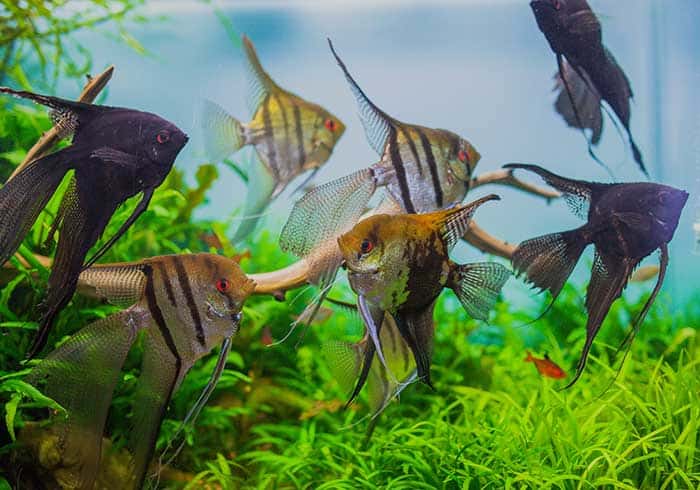
Angelfish prefer a minimum tank size of around 20-30 gallons, and they will need a tall tank with plenty of swimming space. You will need to account for the size that angelfish will often grow and their unusual shape, which means they are taller than they are long.
How To Stop Angelfish Bullying
Above I have explained that much of an angelfish’s aggression is caused by stress and territorial behavior, but what if you have a simple case of bullying?
Bullying behavior will usually happen when angelfish are in larger numbers. Angelfish prefer to live in groups of 5 or 6 (or more), but a group of this size may encourage bullying in a community tank.
The best way to stop angelfish bullying in a community tank is to keep a maximum of two angelfish. I have never kept more than two angelfish in a community aquarium, and unsurprisingly, I have never experienced any long-term aggressive behavior or bullying.
Angelfish are very social and like the company of other fish. By keeping only two angelfishes together, they will be more likely to interact with other fish in the tank.
If you specifically have an angelfish tank, you can keep larger groups of angelfish. However, another cause of aggression is when angelfish begin to breed.
Breeding time is when angelfish will probably be most aggressive, so you need to provide a tank with plenty of space to avoid conflict.
Can Angelfish Be Kept Alone
When kept alone, angelfish tend to become more stressed and withdrawn and will often spend their time hiding away.
Because angelfish like the company of their own species, it would be kinder to keep them in pairs for community tanks or in larger groups if you have an angelfish tank.
How Many Angelfish In A 55 Gallon Tank
If you have a 55-gallon tank, you can keep up to six angelfish. The general rule is that each angelfish will need 10 gallons of tank space to allow them to swim freely and limit any territorial behavior.
I have picked a 55-gallon tank as a starting example. For every 10 gallons above or below, you can add or remove one angelfish, but I wouldn’t recommend putting angelfish in a tank smaller than 20 gallons.
Wrap Up
Hopefully, by reading this short article, any concerns you may have about mixing angelfish in a communal tank have been put to rest.
Angelfish are generally peaceful fish and a great addition to most tanks. Angelfish are also pretty easy to care for (even for beginners).
Angelfish are not inherently aggressive like some fish, and you wouldn’t want to mix angelfish with boisterous, aggressive fish such as bettas or African cichlids. Although angelfish probably won’t go looking for a fight, they won’t back down either.


